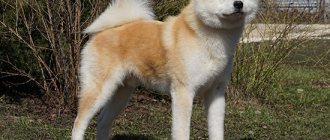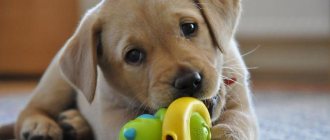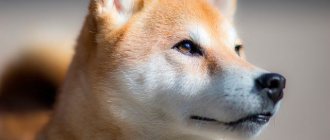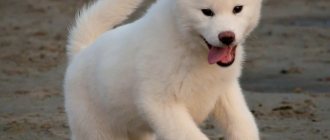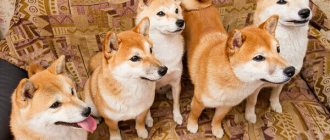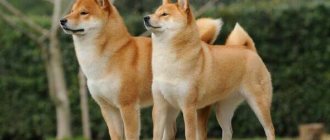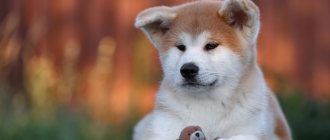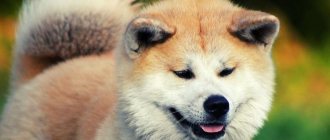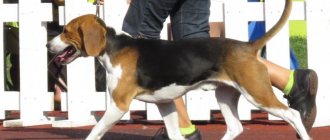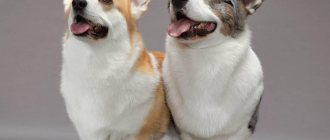Akita Inu and Shiba Inu are popular Japanese dog breeds. And although outwardly they have many similar features, there are many more fundamental differences between them. Differences in the history of origin, size and body features, individual character traits - these are precisely the details that later determined the development of both species.
The Shiba began to be perceived as a companion dog, and the Akita continued to be used exclusively for hunting. What nuances in their appearance and behavior now need to be taken into account when choosing a pet?
Akita Inu
Despite its cute appearance, this breed is different from its four-legged relatives. Among dog trainers and breeders, Akita is perceived almost as a separate brand . Therefore, it is important to familiarize yourself with the main features of these dogs.
Description and photo
Representatives of the Akita Inu breed:
The main highlight of the breed in question is its innate spontaneity and individuality . An animal will be able to demonstrate its natural qualities and high intelligence if the owner begins to raise it from the very first months (and an Akita puppy is considered up to 2-2.5 years inclusive). If you give your dog the attention it deserves, communicate with it often and satisfy its curiosity through games, it is more than possible to get an intelligent and loyal friend as a result.
Having crossed the threshold of adolescence and becoming an adult, the Akita acquires restraint and composure in behavior. From now on she is calm and completely independent. But the silent and confident disposition is just a mask, under which hides a soft, friendly and sensitive creature. Such a pet is very submissive: actita is not at all prone to dirty tricks and willfulness in the house.
We invite you to watch a video about the Akita Inu dog breed:
Exterior
The Akina Inu breed has certain standards . They belong to group 5 “Spitz and primitive type breeds”, section 5 “Asian Spitz and related breeds” and are characterized by a stable exterior:
- a large, but proportional to the body head, similar to an obtuse triangle;
- a wide and flat skull between the ears, with a hollow between the eyes;
- fairly small erect ears, the tip of which should reach the eyes;
- thick and at the same time short neck with powerful muscles;
- developed, wide and deep chest;
- powerful fore and hind limbs, spread to the sides;
- thick coat and soft undercoat, average length over the entire body is 5 cm, but slightly longer on the tail and belly;
- The height at the withers of a male is 66-71 cm, and the size of a female is 61-66 cm.
The appearance of the Akita Inu is quite expressive, because they are included in the list of the most beautiful breeds in the world. According to the requirements, the breed is allowed four color options: red or fawn, with dark tips of hair, brindle and white.
Character
These dogs are very smart and loyal pets and have an excellent memory . From an early age, the Akita is characterized by playfulness and restlessness. Representatives of the breed are fearless and at the same time not aggressive, but in case of danger they will protect their owners to the end. They are independent and curious, so they are easy to train if you manage to find a balance between affection and firmness in training.
Important!
In general, the character of the Akita is a combination of all the positive qualities that are inherent in other breeds. These dogs have practically no negative aspects of their character.
They do not experience unexpected manifestations of aggression or changes in mood. They don’t even bark: only in extreme cases, so teaching this command will be especially difficult.
Owner reviews
Shiba owners appreciate the opportunity to not part with a compact, neat dog both on walks and while traveling, and the availability of keeping them in a small apartment.
Independence and, at the same time, the ability to coordinate one’s actions with others, complex behavioral complexes in communication with the owner (postures, sounds and facial expressions) make life with a dog interesting and enjoyable.
Her abilities are wide and limited only by her size. She is ready for primitive living conditions, is able to participate in hunting and help herd livestock, and will warn of the appearance of a stranger or animal. But the main thing is that the Shiba Inu will be a worthy, often the most sincere company for the traveler and lover of walks, the villager and the resident of the metropolis.
Additionally, check out the video about the Shiba Inu dog breed:
Shiba Inu
The Akita's sibling may appear to be an exact copy of the above breed . But in fact, completely different standards are applied to such dogs. And the character of these pets is significantly different, which makes them truly unique animals.
Description and photo
Representatives of the Shiba Inu breed:
The Shiba Inu is distinguished by endurance, quick reaction and a developed instinct of self-preservation . Therefore, representatives of this breed are considered excellent watchdogs, but as guards they are noticeably inferior to other pets.
These animals use a whole complex of smell, hearing and vision, and use their innate maneuverability to the maximum to correctly assess the situation. At the same time, Shiba Inu are unpretentious in terms of living conditions and food. They build highly individual, complex and flexible relationships with each family member.
Their character is based on goodwill, which describes the dog as a companion or loyal friend. These dogs love meeting new people . At the same time, they are extremely curious: the more they know about the habits of others, the more comfortable they feel. It is vital for them to feel like they are in a “pack” and understand that their immediate environment is friendly and safe.
We invite you to watch a video about the Shiba Inu dog breed:
Exterior
The Shiba Inu is recognized as a breed by the International Canine Society based on the following standards:
- wide, high-cheekboned head with a pointed (fox-shaped) muzzle;
- almond-shaped, slightly slanted dark eyes;
- small, triangular ears, with a slight forward tilt;
- proportionate, well-built and muscular body;
- thick and short neck with pronounced withers;
- wide back of medium length, with a strong loin and sloping croup;
- straight, erect limbs;
- height 35-42 cm with weight 9-14 kg.
Note!
Despite generally accepted norms, such defects as undershot or undershot are allowed in the breed. But hanging ears and a short, uncurled tail are already considered reasons for disqualification. Of the main colors, the Sibu Inu standard describes several types: red, black and tan and sesame (black and red).
Character
This breed is notable for its very independent character; it is a brave and proud animal, so it is not recommended for novice lovers to have it. Such an active pet must be skillfully guided in the right direction and a clear training strategy is required from the first days - this is the only way to cope with a stubborn pet.
Shiba Inu is capable of demonstrating a whole range of emotions: from joy to deep sadness. These dogs have high intelligence . Even if your four-legged pet does not respond to commands, this means that the dog is simply not in the mood to obey. And when the owner does not have a commanding tone and firmness, then such a reaction can become the main trait in the pet’s character.
Without proper training, a Shiba Inu will turn out to be not a friend, but a burden. You need to be able to negotiate with an animal and make it clear who is in charge in the house.
Appearance Difference
Despite the similarity in the color of the coat, as well as the entire structure of the body, there are still external differences. By themselves, Akita Inu dogs are larger and heavier than representatives of the Shiba Inu breed.
Characteristics of Akita Inu Shiba Inu
| Characteristics | Akita Inu | Shiba Inu |
| Height | 70 cm | 40 cm |
| Weight | 40 kg | 9 kg |
| Wool | Thick and coarse, the undercoat is voluminous but soft | The undercoat is thicker than the main coat. The coat is short and moderately hard |
| Eyes | Eye color brown | Brown eye color |
| Legs | The hind legs are longer than the front legs at the hip | Paws are the same length |
| Tail | Long, tightly twisted into a circle | The tail is voluminous and fluffy, curled into a circle |
| Frame | Small, the neck hardly stands out | A small, smooth transition from head to body. |
| Muzzle | Pointed, fox-like | Pointed, slightly wide skull |
| Ears | Triangle shaped | Triangle shaped ears pointing up |
Important! Beginners in dog breeding may also confuse these two breeds due to the fact that the dogs have a similar coat to the touch.
Shiba Inu
What is the difference?
How are dogs different? Akita and Shiba Inu seem to be a single breed to many people . But professionals are well aware of the differences between these dogs. The main differences can be traced not only visually, but also through the behavior of the pets.
The following points are highlighted where the descriptions of animals directly oppose each other:
- Origin story . The Japanese Akita is a native Spitz-type dog that evolved through domestication rather than selective breeding. But the Shiba Inu is the result of artificial breeding, crossing several breeds.
- Size . The Akita is much larger than the Shiba Inu, which should definitely be taken into account when choosing a pet. You should not start the first breed in a small apartment, because a private house is more suitable for it, when, as a second representative, it will get along well in more modest housing.
- Grooming . The Shiba Inu has a less fluffy coat, which makes grooming much easier. If it is recommended to comb it with an ordinary brush once a week, then the Akita Inu needs a special massage comb with sparse teeth and a slicker brush.
- Cleanliness . It is really worth bathing your Akita often - about 2 times every six months due to its thick coat. And a Shiba Inu will only get by with one bath in the same 6 months. They don't like dirt even for a moment of tomfoolery and prefer dry weather for walking.
- Temperament . By nature, Akitas are obedient and receptive dogs that have a sensitive temperament. They become attached to their owner for life. But Shiba Inus show affection through discipline, because in their character there is a significant predominance of calm.
Differences in maintenance and care
There are no special differences in how dogs are kept; they can live both in a city apartment and on the street. Akita Inu is more adapted to harsh winters; it can be left outside in winter. It is easier to keep a Shiba in an apartment; it will take up much less space.
The main care task is to maintain the cleanliness of the coat. At the same time, the owner will have less trouble with the Siba, since the breed is smaller in size and has two layers of wool. But both dogs need to be brushed no more than once a week, and bathed only 2-3 times a year.
During shedding, combing is done with a special glove; it is logical that a larger dog will lose more hair. Brushing will have to be increased to daily. Dogs shed twice a year for two to three weeks.
It is not advisable to simply wipe your ears and eyes. This is resorted to only in the presence of obvious contamination.
Nail trimming is necessary at least once a month, and walks with dogs should be regular. Akita likes to walk for about an hour and a half; for Shiba, a 40-minute walk will be enough.
The diet of dogs is practically the same; the ideal diet would be according to the old Japanese diet: with a sufficient amount of fats, proteins and carbohydrates. It is strictly forbidden to give sweets to dogs; these breeds are very sensitive to it. Akita will eat more, but not critically.
Breeds rarely suffer from genetic or acquired diseases. The average life expectancy of Akita is 12 years, Shiba is 13 years. Vaccinations for puppies are standard and they cost the same.
What are the similarities between these breeds?
It is also impossible to say that representatives of both breeds are completely different from each other. After all, almost the same requirements are put forward for the appearance of Shiba Inu and Akita in such standards as:
- deep-set and slightly slanted triangular-shaped eyes;
- proportional, muscular build of the body (in males it is more angular and rough, and in females it is refined and light);
- the nose, eyelids and lips are black (although brown is sometimes allowed in white dogs);
- large wedge-shaped head with a short muzzle;
- tail in a ring that lies on the back;
- triangular, wide-set and erect ears;
- powerful paws with tightly pressed toes.
Important!
It is worth noting the repetition of individual character traits. Both the Shiba Inu and the Akita are known for their good nature, friendliness, and “companion” persona. Properly planned training also goes well for both breeds.
To avoid confusion: the main differences between Akita Inu and Shiba Inu
The similarity between the two breeds is not surprising, given that one of them is the ancestor of the other. First, Shiba Inus appeared in Japan. This was in the 3rd century BC. Already in the sixth century, communities were organized in Japan that developed the first Shiba Inu standards and compiled instructions for care, maintenance and training.
Shiba Inu is also called Shiba Inu or Shiba Ken
Eastern dog breeders crossed the Shiba Inu with other breeds as experiments. By crossing the Shiba Inu with the Tosa Inu and mastiffs, a new type of dog emerged (this happened around the 15th century). These turned out to be quite large and strong dogs, suitable for hunting wild boars, deer and even bears. The breed was named Akita Inu.
Akita Inu is also called Japanese Akita or Matagi-ken.
Difference in structure and appearance
In fact, you can only confuse Akita Inu and Shiba Inu in pictures or by briefly looking at the dogs from afar. When two dogs of these breeds stand side by side, their significant difference in size immediately catches the eye. The Akita Inu is larger than its counterpart - the height at the withers of an adult is 61–67 cm, and the weight reaches 50 kg. The Shiba Inu grows up to 39 cm in height and weighs about 10–12 kg.
The difference in size between Shiba Inu and Akita Inu of the same age is obvious
Similar features include a round muzzle with expressive cheeks, wide and slightly slanted eyes of a dark color, neat high-set triangular ears and a tail curled into an elastic ring. Otherwise, these are completely different dogs:
- Akita Inu have a wider and shorter muzzle, making them look like cubs.
- Shiba Inu have sharper teeth, but Akita Inu have a stronger bite.
- The Akita Inu's body is denser, with a broad chest. The back of the Shiba Inu is narrower.
- The Akita Inu's hind legs are slightly higher than the front legs, while the Akita Inu's have the same height.
- The Shiba Inu has a less thick and dense coat, while the Akita Inu has softer hair to the touch.
- The color of the Shiba Inu can be red, black and tan and sesame. Akita Inu - pure white, red and white, brindle.
The public's favorite Hachiko is an Akita Inu, as evidenced by his size and character.
Video: comparison of Shiba Inu and Akita Inu
Difference in character
Puppies of both breeds are distinguished by considerable playfulness and curiosity. The difference is that as the Akita Inu gets older, it becomes a calmer and more reasonable dog, while the Shiba Inu may retain puppy mischief for the rest of its life. The common thing is that representatives of these breeds quickly learn commands and obey their owner. Just remember that both Akita Inu and Shiba Inu are stubborn, willful, and touchy. That is why, when training, you need to show calm and patience, not raise your voice, and especially not threaten with physical punishment.
The Shiba Inu (on the right) even as an adult retains the spontaneity of a puppy, while the Akita Inu (on the left) is a rather stern dog
Akita Inu are quite tolerant towards other dogs, but they are not particularly friendly (they only communicate with well-known dogs). If it seems to them that someone is threatening them or their owners, they immediately go on the attack (these are hunting animals, they are strong in a fight). They don’t particularly like small children, so families with small children are better off not getting such dogs.
The Shiba Inu is more tolerant of both other animals and small children. In the house, Sibas get along even with cats. Just don’t let your dog near rodents and birds - there is a high risk that the hunting instinct will kick in and the dog will attack its prey.
Differences in dog care
In terms of care, both Inus are quite similar. One of the features worth noting is the fact that due to their more mischievous nature, Shiba Inus tend to get dirty, so you will have to bathe them more often. Another difference lies in the combing methods. A less furry Shiba Inu should be brushed once a week with a rough brush, while an Akita Inu should be brushed with a soft-bristled comb. Both dogs shed twice a year. During shedding, they should be brushed daily with a slicker brush.
Both breeds require the same walking regimen - at least twice a day for 1.5–2 hours with plenty of physical activity (jogging, playing, training)
As for nutrition, Shiba Inus are less fussy eaters. They can be given both ready-made food and natural food. The main thing is to ensure that the nutritional value of your daily diet is 30% protein, 20% fat and 50% carbohydrates. It is better to feed Akita Inu natural food. They need more protein foods.
Price difference
Akita Inu puppies with pedigree in Russia cost about 90 thousand rubles. The presence of small defects in the breed (for example, a slight deflection in the lower back or a short muzzle) reduces the cost to 35–40 thousand. Shiba Inu are more common dogs, therefore they cost less: pet class - 15–20 thousand, show class - 60 -70 thousand rubles.
If you want to save a little, you can buy an adult Inu (over a year old). Then the dog will cost about 10–15 thousand rubles. But most often, such dogs do not correspond to the breed (which is why they are not bought as small puppies). In addition, by this age, dogs have already formed their character; it will be difficult to train them to suit you.
Which breed is best suited for indoors and outdoors?
The Shiba Inu is a very sociable and active dog . To maintain order in the apartment, it is necessary to provide your pet with regular physical activity. If the animal does not feel tired, it will direct its energy in a different direction - it will decide to try everything. They will begin to chew things, household items, wires and furniture not because of their harmful nature, but because they want to play.
And when keeping this breed in the yard, you should take into account that they do not like leashes and collars. It is undesirable to chain them, despite their tendency to escape, because this can lead to aggression on the part of the animal. In turn, an enclosure or yard is allowed under one condition: a sufficient amount of communication from the owner.
For the option with an apartment, an Akita Inu is much better suited. They also need regular and prolonged exercise to remain calm and obedient. But this breed is much less likely to misbehave. If you give her a decent corner with a sleeping place and toys, then she will spend a significant amount of time there without any problems.
When kept in an enclosure, the requirements for the pet's comfort will be overestimated : it is necessary to have a warm booth, a place for walking and a high fence. Only under such conditions will the Akita feel cared for.
Why are these different dogs: history of breeds
Akita Inu is a Spitz breed. The history of its appearance is not connected with selection; it did not appear as a result of crossing certain breeds. Everything is much simpler, the ancient ancestors of the breed were simply domesticated by humans at one time.
It is often difficult to distinguish an Akita from a Shiba from a photo.
Later, the Akita became the favorite breed of the Japanese nobility. Noble dogs in rich houses were even entitled to their own separate apartments and their own servants. But in return, the breed was required to have strength and calmness, as befits a true samurai.
For your information! A difficult period in the history of the breed was the years of World War II, when the Akita Inu was called up to serve in the active army. The result was the almost complete destruction of this breed. And only thanks to the work of Japanese breeders in the post-war years, the breed was preserved and became very popular far beyond Japan.
But the Shiba Inu, unlike the Akita, is the result of the painstaking work of breeders. Over a long period of time, local dog breeds continued to be bred until they achieved the desired result - a breed for hunting waterfowl.
Over time, the Shiba Inu, as it is also called, became popular among Buddhist monks and Japanese peasants due to its small size and guarding abilities. And only in the last century, although the breed has a long history, the Shiba began its conquest of Europe and the USA, where today it is in great demand.
Although today the breed has lost its hunting abilities and is bred primarily for its decorative value for the home and for display at specialized exhibitions.
Both breeds have thick coats
Opinion of a real breeder about the differences between dogs
In one of the interviews, the owner of the Amanogawa nursery, Maria Spirts, tried to draw a line between such seemingly similar breeds. According to the breeder, Akita Inu and Shiba Inu are dogs that have very high intelligence and are ready to defend their owner. But if the Shiba Inu limits itself to “a menacing growl and bark, with the help of which it will keep the stranger away from itself,” then in the case of the Akita, “a fight is guaranteed, because the dog will prove its superiority to the last.”
According to Maria, among Akita Inu dogs there are many dominant ones. While the Shiba Inu thinks and acts more rationally, is patient and ready to compromise in case of danger.
Health
Akita and Shiba are considered long-lived. The difference is in life expectancy: Akita 11-12 years, Shiba - 12-15 years. The list of characteristic diseases includes food intolerance (allergies); skin diseases caused by allergies; hip dysplasia; diseases of the digestive system.
Routine vaccinations are mandatory. They are the same for Akita and Shiba. Vaccination against dangerous diseases such as rabies and plague will protect pets from fatal diseases. An unvaccinated dog poses a threat to the lives of other animals and humans.
Attitude towards children and pets
An Akita will be very tolerant of children if they have lived together since childhood. With the right approach, purebred dogs will become faithful companions for children over 8 years old . When interacting with a younger child, this breed does not perceive sudden movements and noise well, so they can often show aggression and self-defense in response to unexpected movements.
Important!
Dogs have a good memory, which is why they remember the slightest offense towards a child (pushes, tugging, blows). The Akita Inu is even more hostile towards other dogs: it always tries to dominate the dogs, which is why conflict situations arise.
Shiba Inu will be more subtle psychologists, capable of perfectly studying the characters and habits of the surrounding household members. Despite their blind love for their owner, pets are wary of physical contact (stroking, attempts to put on a collar, etc.), responding with an indignant howl to any attempts. To avoid such a reaction, your four-legged friend needs to be taught affection from an early age.
For children they can become nannies and companions. Dogs are hostile towards strangers , although they will not show aggression without reason. But they find it difficult to get along with other animals and often show jealousy (especially with cats).
Character
Typically, Japanese people can describe the Shiba Inu's character in three words: brave, friendly and charming.
Such incompatible qualities coexist in one pet the first time. These are brave creatures with excellent intelligence and prudence.
Friendly Shiba Inu are very innocent and docile in front of their owner, although they are prone to self-centeredness and maximum manifestation of leadership qualities.
Often the Shiba Inu is characterized by a love of freedom and a stubborn disposition, so the owner should show persistence and firmness when raising the puppy from the first day.
To ensure that the dog obeys its owner, nurseries begin socialization from an early age, correcting the habits and behavioral characteristics of arrogant puppies.
Despite their independence, these are quite disciplined dogs. Leaving more natural instincts, qualified breeders in nurseries make their character softer.
The dog may ignore the owner's command if it finds it uninteresting. They treat the owner with love and devotion, but do not tolerate excessive tenderness towards themselves.
Although even as adults they love to frolic like puppies . They can commit minor pranks and then beg forgiveness from the owner with an innocent look.
It is also worth paying attention to the facial expressions of the Shiba Inu. With their charming smile, they are able to express a whole range of emotions: mockery, cheerfulness, devotion and even indignation.
It is rare to see Shiba Inus barking; alternatives to this are specific sounds: grunting, squealing, howling and even laughing.
Despite the modest description of the size of dogs of this breed, they show good watchdog qualities.
They are able to control the situation, rushing to stand up for the owner and their own territory. They try not to miss a single sound.
Who is more picky about feeding?
The main feature of the Akita Inu is its high tendency to food allergies. In Japan, the breed ate dietary food: fish, rice, vegetables, seaweed salads and seafood. Therefore, the diet should be light and low-calorie, because excessive amounts of fat and grains lead to allergies.
The most common cause of allergies is chicken. Dogs are genetically predisposed to eat fish, and large amounts of meat (especially chicken) in the diet can cause rashes and eczema. The dog may even lose its undercoat. Ready-made dry and wet mixtures for Akita Inu can also be a simple solution to the problem. In addition, the animal should always have access to fresh water.
The Shiba Inu's native food is seafood . Therefore, it is recommended to select individual ready-made food that includes a specific type of protein, but not beef or soy. Natural nutrition may include varieties of fish with healthy fats - salmon or tuna, meat products - duck or lamb.
It is better to make the basis of the diet with ready-made fish food for puppies, low-fat fermented milk products, raw and boiled vegetables, fruits (zucchini, pumpkin, apples) and rice. At the same time, it is necessary to give the puppy specialized supplements rich in calcium for the proper formation of the skeleton.
Feeding
To ensure a healthy and long life, your pet needs a balanced diet. How to feed: natural or industrial feed, depends on the desire and ability of the owner. Shiba Inu and Akita are of the same origin, so the diet is similar.
If dry granules are used, it should only be Super Premium food. It is believed that granulated food fully satisfies the Japanese people's need for nutrients and minerals. Balanced feeds are safe and convenient in dosage. Many dog breeders prefer to feed their pets natural food.
The difference in the diet of Akita Inu and Shiba Inu from other breeds is that it is undesirable for them to be given meat and meat products in large quantities. Instead, fish becomes the mainstay of nutrition.
Historically, the Japanese ate mainly fish, seaweed, vegetables and fruits. Now many generations of dogs are not native Japanese, but at the genetic level, diseases associated with an unusual diet are possible.
When eating natural foods, the following are excluded from the menu:
- Smoked meats.
- Pickles.
- Seasonings.
- Sweet baked goods.
- Confectionery sweets.
- Fatty meat of pork, lamb.
- Poultry meat and bones.
- Corn grits.
- Fatty dairy products.
Products that must be consumed: low-fat sea fish, lean beef, raw and boiled vegetables and fruits, cereal products.
Comparison by other criteria
If we evaluate the pet’s attachment to its owner, then the Akita is more emotionally dependent on its owner. It is difficult to discern love in an adult dog, but they still remain very loyal dogs. But the Shiba Inu is not ready to share its love with everyone: it will only maintain partnerships with family members, but it will love its owner immensely and obey more.
Definitely, the Akita Inu is the more popular breed because of the story of Hachiko . Pet-class puppies cost approximately 20 thousand rubles. (50-80 thousand rubles for purebreds). But the Shiba Inu costs 50% less - about 13 thousand rubles. (or 25-50 thousand rubles for a pet with a good pedigree). It cannot be said that nurseries of the mentioned breeds are a rarity for the country. But in Russia there really aren’t that many of them: Indigo-Smile, Mai Hoshi, Milana Light, Zoomir and Hangy’s Anet.
Comparison of prices for puppies
The pedigree of both breeds, going back to the time of the samurai, does not make it possible to purchase a puppy at a low price. If we talk about truly Japanese breeds, without other breed admixtures. On the puppy sales market you can often find Akita Inu or Shiba Inu puppies being sold for 5 thousand rubles or less.
It is necessary to remember that in order to take a real dog with real Japanese roots of one of these breeds outside the borders of Japan, and even legally, you need to collect a lot of documents, pay a lot of expensive duties, all these points simply will not allow the breeder to sell puppies at such a low price.
Most likely, a puppy offered as an Akita Inu for such a price will be obtained by mixing similar breeds. The buyer may not notice this immediately, but only after a while, when he does not notice samurai behavior in the character of his pet and is susceptible to aggression from the dog.
Shiba Inu
Therefore, those who want to buy a real Akita Inu or Shiba Inu with true Japanese roots choose good kennels that have all the documentation confirmed on the other hand. In addition, puppies will cost about 30-70 thousand rubles , depending on what awards his parents or ancestors have. Therefore, when purchasing puppies of these breeds, you should carefully consider the choice of kennel and dog breeder.
Price difference
Prices for Akita Inu puppies range from 20 thousand rubles, but for a Shiba Inu puppy you will have to pay at least 30-40 thousand rubles. At the same time, the cost of males of both breeds is approximately 10 thousand rubles less than the cost of females.*
Note! The prices shown apply to puppies, but an adult animal will cost much less. However, you should be aware that an adult dog has a mature character and the presence of certain attachments. Therefore, it will take much more time to adapt to a new place and get used to the new owners.
The price of animals is influenced by the class to which they belong:
- the show is dogs without the slightest flaws, standards of the breed. They participate in all kinds of exhibitions and are used for breeding;
- breed - animals that have minor deviations in structure, but can boast of good reproduction. They are quite suitable for breeding, but at exhibitions it is not always possible to become a winner;
- pet - puppies that have errors in standards or defects that do not harm their health. However, this class is not used either for exhibitions or for breeding.
For an Akita, the conditions of a private home are more suitable
